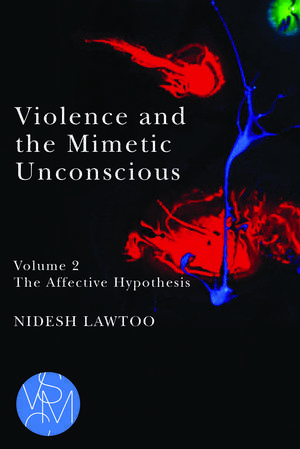Violence and the Mimetic Unconscious, Volume 2: The Affective Hypothesis: Studies in Violence, Mimesis & Culture
Autor Nidesh Lawtooen Limba Engleză Paperback – oct 2023
Din seria Studies in Violence, Mimesis & Culture
-
 Preț: 172.04 lei
Preț: 172.04 lei -
 Preț: 165.57 lei
Preț: 165.57 lei -
 Preț: 268.46 lei
Preț: 268.46 lei -
 Preț: 521.55 lei
Preț: 521.55 lei -
 Preț: 187.97 lei
Preț: 187.97 lei -
 Preț: 189.69 lei
Preț: 189.69 lei -
 Preț: 226.49 lei
Preț: 226.49 lei -
 Preț: 225.29 lei
Preț: 225.29 lei -
 Preț: 190.61 lei
Preț: 190.61 lei -
 Preț: 256.80 lei
Preț: 256.80 lei -
 Preț: 301.71 lei
Preț: 301.71 lei -
 Preț: 300.99 lei
Preț: 300.99 lei -
 Preț: 123.64 lei
Preț: 123.64 lei -
 Preț: 150.19 lei
Preț: 150.19 lei -
 Preț: 146.27 lei
Preț: 146.27 lei -
 Preț: 119.35 lei
Preț: 119.35 lei -
 Preț: 177.49 lei
Preț: 177.49 lei -
 Preț: 121.95 lei
Preț: 121.95 lei -
 Preț: 122.92 lei
Preț: 122.92 lei -
 Preț: 120.34 lei
Preț: 120.34 lei -
 Preț: 146.80 lei
Preț: 146.80 lei -
 Preț: 181.32 lei
Preț: 181.32 lei -
 Preț: 150.27 lei
Preț: 150.27 lei -
 Preț: 150.73 lei
Preț: 150.73 lei -
 Preț: 119.81 lei
Preț: 119.81 lei -
 Preț: 182.84 lei
Preț: 182.84 lei -
 Preț: 121.50 lei
Preț: 121.50 lei -
 Preț: 151.34 lei
Preț: 151.34 lei -
 Preț: 188.25 lei
Preț: 188.25 lei -
 Preț: 246.54 lei
Preț: 246.54 lei -

-

Preț: 190.50 lei
Nou
Puncte Express: 286
Preț estimativ în valută:
36.45€ • 38.06$ • 30.17£
36.45€ • 38.06$ • 30.17£
Carte tipărită la comandă
Livrare economică 05-19 aprilie
Preluare comenzi: 021 569.72.76
Specificații
ISBN-13: 9781611864656
ISBN-10: 1611864658
Pagini: 316
Ilustrații: 30
Dimensiuni: 152 x 229 x 23 mm
Greutate: 0.42 kg
Editura: Michigan State University Press
Colecția Michigan State University Press
Seria Studies in Violence, Mimesis & Culture
ISBN-10: 1611864658
Pagini: 316
Ilustrații: 30
Dimensiuni: 152 x 229 x 23 mm
Greutate: 0.42 kg
Editura: Michigan State University Press
Colecția Michigan State University Press
Seria Studies in Violence, Mimesis & Culture
Recenzii
In this impressive sequel on violence and the unconscious, Nidesh Lawtoo accounts for the horrorism at play in new forms of contemporary media violence that generate contagious pathologies in the digital age. Sensitive to the pathos of vulnerable subjects in terms of age, gender, race, and education, this remarkable study reloads Plato’s ancient question on the influence of art for mimetic studies from Nietzsche to Arendt, affect theory to the neurosciences, Greek tragedy to video games to the storming of the U.S. Capitol.
—Adriana Cavarero, honorary professor of political philosophy, University of Verona, and author of Horrorism: Naming Contemporary Violence
To grasp the speed, complexity, and contagiousness of violence today, as it crosses daily experience, the new media, neofascist movements, and circles back again, Lawtoo finds it imperative to supplant the Freudian unconscious with a mimetic unconscious that is at once collective, differentiated, porous, and suggestible. The result is an innovative, courageous, and powerful study that is indispensable today.
—William E. Connolly, author of Resounding Events: Adventures of an Academic from the Working Class
In this latest installment of his long-standing inquiry into the “will to mime” that drives humans at an unconscious level, Lawtoo moves mimetic theory into the present, in order to confront what he calls the “hypermimetic crises” associated with contemporary media. Moving from the ancients and Nietzsche to pop culture and the most up-to-date scientific work on the operation of mirror neurons in the human brain, this fascinating book suggests that maybe Plato was right, after all, and representations of violence—fictional or real—pose a threat of '"mimetic contamination," of an irrationally compelled imitation of the represented acts.
—Henry Staten, professor in the humanities at University of Washington, and the author of Techne Theory: A New Language for Art
—Adriana Cavarero, honorary professor of political philosophy, University of Verona, and author of Horrorism: Naming Contemporary Violence
To grasp the speed, complexity, and contagiousness of violence today, as it crosses daily experience, the new media, neofascist movements, and circles back again, Lawtoo finds it imperative to supplant the Freudian unconscious with a mimetic unconscious that is at once collective, differentiated, porous, and suggestible. The result is an innovative, courageous, and powerful study that is indispensable today.
—William E. Connolly, author of Resounding Events: Adventures of an Academic from the Working Class
In this latest installment of his long-standing inquiry into the “will to mime” that drives humans at an unconscious level, Lawtoo moves mimetic theory into the present, in order to confront what he calls the “hypermimetic crises” associated with contemporary media. Moving from the ancients and Nietzsche to pop culture and the most up-to-date scientific work on the operation of mirror neurons in the human brain, this fascinating book suggests that maybe Plato was right, after all, and representations of violence—fictional or real—pose a threat of '"mimetic contamination," of an irrationally compelled imitation of the represented acts.
—Henry Staten, professor in the humanities at University of Washington, and the author of Techne Theory: A New Language for Art
Notă biografică
Nidesh Lawtoo is professor of Modern/Contemporary European Literature and Culture at Leiden University, Netherlands. He previously led the ERC project Homo Mimeticus: Theory and Criticism, and he is the author of several books inaugurating a new theory of mimesis at the intersection of philosophy, literature, and politics, including The Phantom of the Ego (2013), Conrad’s Shadow (2016), (New)Fascism (2019), and Violence and the Oedipal Unconscious (2023).
Descriere
Representations of violence are said to have subliminal contagious effects, but what kind of unconscious captures this imperceptible affective dynamic in the digital age? In volume two of a Janus-faced diagnostic of the cathartic and contagious effects of (new) media violence, Nidesh Lawtoo traces a genealogy of a long-neglected, embodied, relational, and highly mimetic unconscious that, well before the discovery of mirror neurons, posited mirroring reactions as a via regia to a phantom ego.
